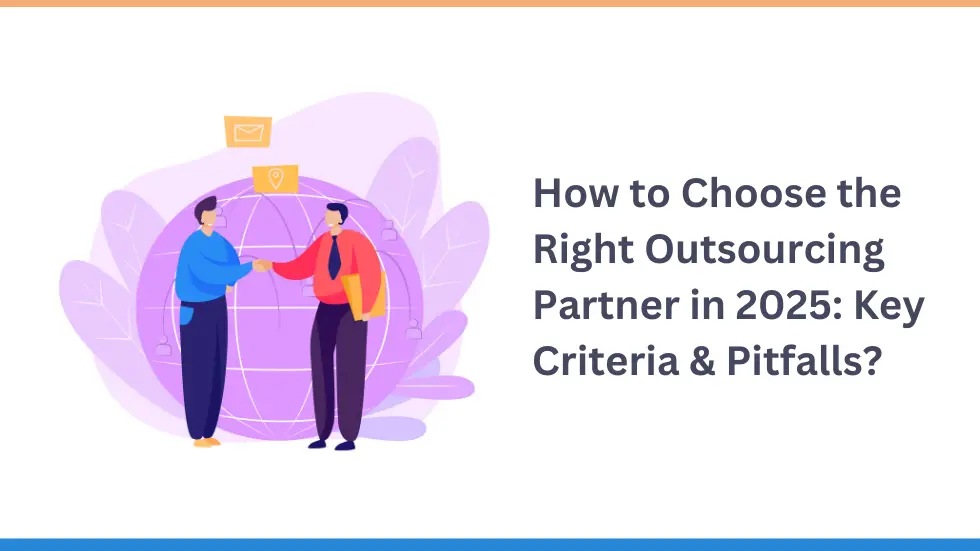Outsourcing continues to be a powerful lever for scaling, accessing talent, and managing cost. But picking the wrong partner can lead to missed deadlines, quality issues, security risks, and alignment problems. In 2025 — with fast technology shifts, AI, remote work — the stakes are higher. Here’s how to choose smartly.
1. Why the Right Outsourcing Partner Matters More Than Ever
In 2025, outsourcing isn’t just about cost arbitrage or filling resource gaps. You’re expecting:
- High velocity & continuous delivery
- Domain specialization (AI, cloud, data, etc.)
- Tight security, regulatory compliance
- Remote / distributed collaboration as default
- Ability to pivot or change direction quickly
A partner that fails in any dimension becomes a drag, not an enabler.
2. Core Criteria to Evaluate Potential Partners
Below are the key criteria you must assess. Missing any can lead to major headaches.
2.1 Clear Scope & Requirements
You must begin with clarity: what exactly do you need them to deliver? The features, modules, integrations, anticipated load, support, maintenance, etc. Without this, expectations diverge early.
Sources commonly emphasize “Define your project’s scope” as Step 1 to choosing a partner.
2.2 Technical Expertise & Technology Stack
- Do they have experience with the exact stack you require (frontend, backend, databases, cloud, AI, etc.)?
- Have they handled comparable complexity, scaling, performance challenges?
- How up-to-date is their team in modern technologies (cloud-native, microservices, serverless, AI integrations)?
For product development outsourcing, blogs advise assessing QA, past performance, and technology fit.
2.3 Reputation, References & Track Record
- Check their portfolio, case studies, client testimonials.
- Look them up on review platforms (Clutch, GoodFirms, etc.).
- Interview or contact prior clients to ask about delivery, quality, communication, reliability.
Reputation is often cited as one of the essential qualities for outsourcing partners.
2.4 Communication, Cultural Fit & Transparency
- Do they use tools, processes, meeting cadences that align with you?
- How do they handle time zone differences?
- Are there language or cultural barriers?
- Is there transparency in progress, challenges, reporting?
Poor communication is one of the biggest failure points. Many guides warn of “communication barriers” and misalignment.
2.5 Security, IP & Compliance
- Will they sign NDAs, Service Level Agreements (SLAs)?
- What security, encryption, data protection practices do they follow?
- Are they compliant with regulations relevant to your domain (GDPR, HIPAA, etc.)?
As projects handle more sensitive data, this becomes non-negotiable. Clarion’s best practices highlight supporting security and compliance standards like ISO, SOC2.
2.6 Scalability, Flexibility & Adaptability
- Can they scale team size up or down as project demands shift?
- Are they willing to pivot, accommodate changes, evolve scope?
- Do they support flexible engagement models?
Many guides emphasize flexibility as a key quality.
2.7 Contractual Models & Pricing
- Fixed price? Time & materials? Dedicated team?
- Are there hidden costs, escalation clauses, overage terms?
- Are incentive models or outcome-based pricing considered?
You want alignment so your partner isn’t incentivized to stretch scope arbitrarily.
2.8 Governance, KPIs & Monitoring
- Define clear KPIs / metrics (throughput, defect rate, cycle time, uptime) up front.
- Review cycles, reporting, milestones, dashboards.
- Use pilot or trial periods to test fit.
Clarion’s best practices suggest defining business-focused KPIs and evaluating vendors across scenarios.
3. Common Pitfalls / Mistakes to Avoid
Here are some traps many fall into:
- Vaguely defined scope leading to scope creep
- Choosing purely on cost, ignoring quality or reliability
- Ignoring communication / cultural mismatches
- Underestimating security / data risk
- No fallback path or exit strategy
- Overreliance on promises without verifying track record
- Signing contracts without governance, metrics, audits
- Assuming “best for today” will scale for future challenges
4. Emerging Trends & Considerations in 2025
As technology evolves, here are trends you need to consider:
- Expect partners to have AI / ML / generative AI capabilities
- Demand cloud-native, microservices, serverless expertise
- Data privacy, ethical AI, model governance becoming mandatory
- Hybrid delivery: part onshore, part offshore, local leadership
- Vested / relational outsourcing models (shared outcome contracts)
- Pilot / risk-free trial engagements before committing
5. Step-by-Step Decision Framework
Here’s a pragmatic flow you can follow when selecting:
- Prepare your requirements & goals
- Shortlist based on domain & tech fit
- Check reputation, references, case studies
- Interview & evaluate communication, process, culture
- Test via small pilot or PoC
- Negotiate contract with KPIs, governance, security
- Monitor closely initially; adapt / refine as you proceed
- Have clear criteria for scale, exit, or handover
6. Conclusion & Action Plan
Choosing the right outsourcing partner in 2025 means going beyond cost — you need alignment in strategy, trust, technical excellence, security, adaptability, and governance.
Additional Resources:
